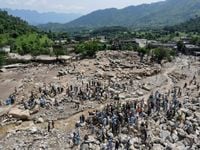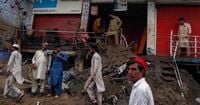In the rugged hills of northern Pakistan, scenes of devastation and heartbreak have unfolded over the past week as relentless monsoon rains triggered catastrophic flash floods. By Tuesday, August 19, 2025, the official death toll had soared beyond 360, with more than 150 people still missing and entire villages in the Khyber Pakhtunkhwa province left in ruins. The disaster, described by many as unprecedented in its ferocity, has once again exposed the vulnerability of Pakistan’s mountainous communities to the growing threat of extreme weather.
The crisis began in earnest on Friday, August 15, when the district of Buner, about 100 kilometers northwest of Islamabad, was struck by a rare and violent cloudburst. According to Al Jazeera, more than 150 millimeters (6 inches) of rain fell within a single hour—far exceeding what the parched soil and narrow valleys could absorb. The result was a torrent of water, mud, and boulders that tore through homes, swept away families, and left entire communities buried beneath debris.
By Monday, the situation had become dire. Rescuers were still searching for survivors and the missing, with officials warning that the death toll—already at 350 according to The New York Times—would likely climb as more collapsed buildings were reached and heavy rain continued to fall. In Beshonai, a village of 4,000 people with a river running through its center, only 25 out of 400 houses remained undamaged. Mourners, forced to bury their dead under plastic tarps due to the unceasing rain, spoke of a tragedy that touched every family. "It was like death visited every home," said Abdul Haleem, a local religious figure, after leading his sixth funeral of the day.
The scale of destruction has been staggering. In Buner alone, at least 207 people were killed over two days, as reported by Al Jazeera, and thousands have been displaced. Satellite images revealed mountains and villages, including the town of Pir Baba, engulfed in mud and debris. The National Disaster Management Authority (NDMA) reported that more than 2,700 homes have been damaged across the affected regions, with 941 in Khyber Pakhtunkhwa and 719 in Azad Jammu and Kashmir destroyed or rendered uninhabitable.
Authorities have warned of further deluges and landslides, urging local administrations to remain on high alert as the monsoon season—typically running from July to September—reaches its peak. Since late June, torrential monsoon rains have battered Pakistan, killing more than 650 people and injuring nearly 1,000. The worst-hit province, Khyber Pakhtunkhwa, has recorded 425 deaths, followed by Punjab with 164, according to the NDMA.
For many survivors, the disaster struck with little or no warning. Residents in Buner said that no evacuation alerts were broadcast from mosque loudspeakers, a traditional method in remote areas. The government acknowledged that while early warning systems exist, the intensity and suddenness of the cloudburst left no time to inform residents before the waters hit. "The sudden downpour was so intense that the flooding occurred before residents were informed," government officials told The Associated Press.
The lack of warning has fueled anger and frustration. Some officials have suggested that many deaths could have been avoided if people had not built homes along waterways. On Sunday, provincial chief minister Ali Amin Gandapur said, "Many deaths could have been avoided if residents had not built houses along waterways." He added that the government would encourage displaced families to relocate to safer areas and assist them in rebuilding their homes. Yet, for many like Shaukat Ali, a shopkeeper in Pir Baba whose grocery store was swept away, such comments ring hollow. "We feel hurt when someone says we suffered because of living along the waterways," Ali said. "Our home was not near a stream, yet the flood swept through."
Rescue and relief efforts have been complicated by the region’s geography and the sheer scale of destruction. Roads have been blocked by mud, boulders, and fallen trees, hampering the work of emergency teams. The Pakistan Army has deployed engineers and heavy machinery to clear rubble, while the Pakistan Air Force established an air bridge, airlifting 48 tons of NGO-provided relief goods from Karachi to Peshawar. Nearly 100 people, mostly women and children, were evacuated from rooftops in Darori village, Swabi district, after fresh torrential rains triggered another flash flood on Monday, killing 15 more people.
Prime Minister Shehbaz Sharif convened a high-level meeting on Monday to review relief operations in Khyber Pakhtunkhwa, Gilgit-Baltistan, and Pakistan-administered Kashmir. The estimated cost of damage to public and private property has already surpassed 126 million rupees (about $450,000), according to a government statement. The United Nations and humanitarian agencies have mobilized teams to provide food, water, and other essential aid, especially in areas cut off by damaged roads and communication lines.
Underlying the immediate crisis is the broader challenge of climate change. Lieutenant General Inam Haider Malik, chairman of the NDMA, told reporters in Islamabad that Pakistan is experiencing shifting weather patterns, with this year’s monsoon intensity 50 to 60 percent higher than last year. The country, despite contributing less than 1 percent of global greenhouse gas emissions, is among the world’s most climate-vulnerable nations, regularly facing heatwaves, heavy rains, and sudden disasters like glacial lake outburst floods and cloudbursts.
The memory of Pakistan’s 2022 floods—when more than 1,700 people were killed and a third of the country was submerged—remains fresh. The current disaster, however, has struck the mountainous north rather than the flat plains, demonstrating the unpredictable nature of extreme weather in an era of climate instability. As Aziz Ahmed, a schoolteacher in Buner, described the thunder accompanying the recent rains: "It was so loud I thought the end of the world had come."
With more rain forecast for the coming days, the fate of those still missing remains uncertain, and the full scale of the tragedy is yet to be revealed. For now, rescue workers and volunteers continue their search, racing against time and the elements to bring relief to shattered communities. The scars left by the floods—both physical and emotional—will linger long after the waters recede, a stark reminder of the mounting risks facing Pakistan’s most vulnerable as the climate crisis deepens.


